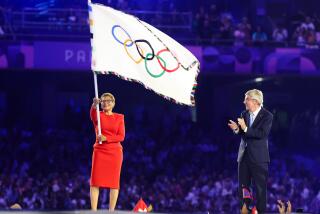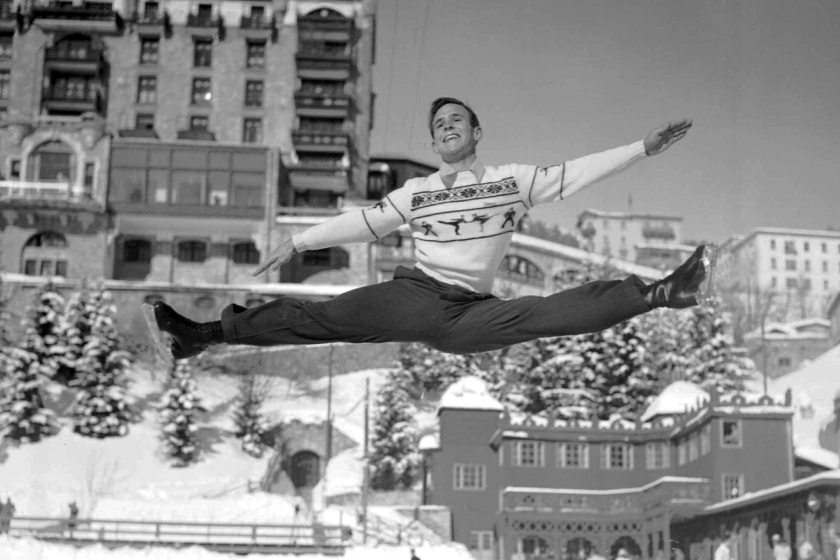Making Waves Over Olympic Training Site : Don’t Pick Our Village, Says Lake Hodges Enclave
- Share via
The natives are making waves at Lake Hodges.
Residents around the North County reservoir have banded together to voice a collective wail against what outsiders might consider the best of luck--an Olympic Village right in their own front yard.
In the unheated engine bay of the Del Dios Fire Station, under the flickering light of a faulty fluorescent tube, about 70 residents met Wednesday night, collecting a war chest, swapping dirty-tricks ideas and signing the inevitable petitions against invasion of their bucolic world.
Del Dios is within the San Diego city limits, a village spread along the west side of the lake and sandwiched between the burgeoning communities of Rancho Bernardo and Escondido. It has not changed a whit in the past 30 years, give or take a few coats of paint and some repairs to leaky roofs.
Ready to Fight
Now, the prospect of a $120-million training camp, of hosting 300 to 600 of the nation’s best athletes year-round and of hundreds of visitors invading their little community to view Olympic contenders has galvanized the community against the possible camp.
They are aware that they are opposing not only “an apple pie-motherhood” issue but also the region’s most powerful officials, who are members of a task force formed to bring the Olympic athletic center to San Diego. Those officials include shopping enter magnate Ernest Hahn, financiers Gordon Luce and Kim Fletcher, thoroughbred horse breeder Gene Klein, Chargers owner Alex Spanos, hotelier Terry Brown, newspaper executive Herb Klein, home builder Harry Summers and Councilwoman Gloria McColl, to name a handful.
Lakeside residents are protesting a proposed site near the city fishing docks that is accessible only through their rustic community.
Another Lake Hodges site on the southern, Rancho Bernardo side also has been selected as a finalist by a San Diego selection committee.
Others still in the running are Mission Trails Park near San Carlos, Lower Otay Reservoir in South Bay, a site north of Carmel Mountain Ranch along Interstate 15, and another in the the lower San Dieguito Valley near Rancho Santa Fe.
U.S. Olympic Committee members have viewed the locations but haven’t picked a favorite or even committed to coming to San Diego.
Preserving Community
Unlike some other NIMBY (not-in-my-backyard) contingents, Del Dios residents have paid the price of keeping their little hamlet and the lake at their front door from changing. A building moratorium placed on the area by the City of San Diego in the 1950s to curtail septic tank seepage into the reservoir has kept residents from modernizing their homes, building a patio or enlarging their properties in any way.
And that’s just the way they like it.
What they have preserved in the galloping growth decades of the ‘70s and ‘80s is a landscape of serenity and beauty for all to view.
Resident Paul Marx described the values that the lakeside dwellers hold dear: “When you come around the bend on Del Dios Highway and look out on this expanse of beauty, your blood pressure drops several points.”
In this era, that ought to be enough of a reason to preserve Lake Hodges, he contends.
Marx, an attorney and a member of the San Dieguito Community Planning Group, warned that “if we allow just one intensive development along the lake,” the battle is lost and sensible planning is out the window.
When posh Fairbanks Ranch allowed a small but pricey shopping center into its estate community, the development was widened to include a needed fire station and a school site, said Marx.
Then, because of the other development, a Montessori school was allowed, and then a Catholic church with a 92-foot-tall tower. Next, he said, a large synagogue is expected to be approved, and waiting in the wings is a 26-acre “cultural center” which includes a supermarket in its plans.
The same thing could happen to Lake Hodges, Marx stressed. If a major training center is built, then the private landowner next door will argue that he needs commercial zoning or at least higher density residential uses on his acreage, “because who would buy a $400,000 home with a view of a gymnasium?”
Making a Dent?
Although small in number and short on clout, the lakeside protesters are beginning to make a dent in officialdom.
Joann Johnson, administrative aid to Councilwoman Abbe Wolfsheimer, said that she and her boss had heard nothing about plans for a Lake Hodges Olympic facility until a month or so ago, when Councilwoman McColl and Hahn met with them “about a small center for a few sports, canoeing, kayakers and luge, I think.”
Wolfsheimer, whose San Diego council district includes the northern part of the city, including the lake, has been campaigning for most of her term in office to turn the entire San Dieguito River Valley, including Lake Hodges, into a linear greenbelt from Ramona to Del Mar. She agreed that the small Olympic facility would fit right in to her passive park plan. “Then, a few days ago, we started getting all these phone calls about this huge Olympic center for every kind of Olympic sport,” Johnson said. “We had never conceived of anything so large. We were really caught off-guard.”
Most of those calls to Wolfsheimer and other officials came from Lake Hodges natives responding to handbills placed in their rural mailboxes by organizers of the Olympic protest. Each flier had the names and addresses of the principal proponents of the training center proposal. Telephone numbers were supplied by word-of-mouth and angry lakeshore residents did the rest.
Fund Raiser
The group has bolstered its efforts with a fund-raising drive that has netted more than $2,000, enough to retain environmental attorney Don Detisch, who earned his fame by halting a planned federal prison from being built near Tierrasanta. The environmental impacts to the pristine lake and shoreline will be the rallying cry if Olympic promoters continue to eye the Del Dios area.
Will Corbett, one of the organizers of the Lake Hodges protest, is a newcomer to the lake, moving to the area less than two years ago from his longtime home in University City--where he watched as an instant city, the Golden Triangle, grew around him.
“I was looking to move to Rancho Bernardo,” he told townsfolk at the fire station meeting, “but then I found this place and moved here. When I heard about this (Olympic center) plan, I was so angry I shook.
“I saw what happened to University City,” Corbett said, vowing not to let it happen to Del Dios.
More to Read
Go beyond the scoreboard
Get the latest on L.A.'s teams in the daily Sports Report newsletter.
You may occasionally receive promotional content from the Los Angeles Times.






